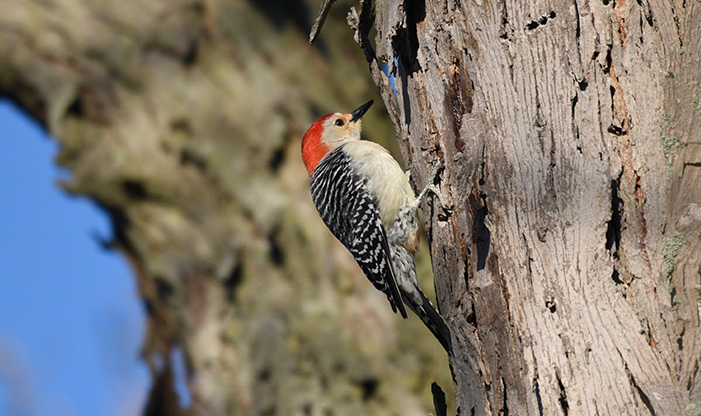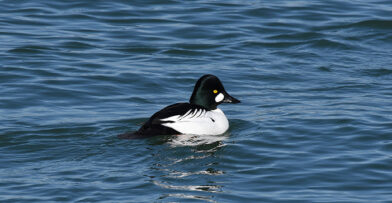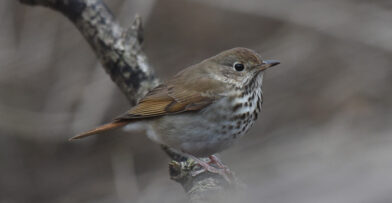Our Bird Profile series highlights a species that is migrating through, breeding, or is a year-round resident of Wisconsin that can be found at Schlitz Audubon or in your backyard.
Name
Red-bellied Woodpecker, Melanerpes Carolinas
Basic Description & Appearance
Named for the male’s difficult-to-see patch of red on its belly, the medium-size Red-bellied Woodpecker measures about 24 cm in length. Both sexes possess a zebra pattern on their back; males display a red forehead, crown, and nape, while females have only a red nape. Juveniles don’t show the red crown. In flight, the adults’ white rump and area at the base of the primaries are visible, with adult plumage looking the same throughout the year. The bill of the Red-belled Woodpeckers is black, their feet appear gray to greenish-gray, and their eyes are deep red to reddish-brown.
Vocalization
Red-bellied Woodpeckers are very vocal, drumming and calling frequently in late-winter and early spring, when they are nesting. They use about six different calls, such as when they establish a nest, call a mate, express excitement, defend territory, or when females announce their approach to the nest.
These woodpeckers are often heard drumming year-round on wooden surfaces like utility poles, stumps, and dead trees, but also on metal roofs and metal streetlight fixtures.
Habitat & Nesting
This bird species is widely distributed through the central and eastern US, found west to the wooded areas of the Great Plains and north to Great Lakes region. They have been expanding their range northward and westward since the 1900s.
They are found throughout most hardwood forest habitats, commonly in oak-hickory forests, and where maple and hackberry are dominant. They also live in bottomlands, floodplains, and mangroves (in the south), as well as mixed pine–hardwood forests and longleaf pine savannas. Red-belled Woodpeckers prefer areas of the forest with a greater tree and understory density but are also found in forests near agricultural areas, in parks, and at bird feeders near forested areas.
Male Red-bellied Woodpeckers are territorial all year long, but mostly during breeding season, which begins when they form pairs in January and February. The first clutches are laid in April, with pairs often nesting once, but two broods can occur in the southern range. They make their nests in dead trees or dead limbs in live trees, also using utility poles and fence posts for cavity excavation.
Diet & Foraging
The Red-bellied Woodpecker is an opportunistic generalist. The species feeds on arthropods, acorns and nuts, fruits, seeds, small vertebrates, and occasionally sap and nectar. They forage mainly from trees, branches, snags, but will also look for fruit on the ground. When eating fruits, nuts, and seeds, they may hang upside down from the terminal branch or fruit cluster. When they need to get through the tough coats of seeds or nuts, they will place the item in the crevice of a tree, smash it with their bill, and pulverize the meat into small, edible pieces.
Their preferred trees during fall and winter are masting trees, such as beech, oak, and hickory, when acorns and nuts are mature, but also maple and ash trees. This woodpecker’s foraging methods include gleaning, probing, excavating, pecking, and bark scaling.
When & Where to Find at Schlitz Audubon
Red-bellied Woodpeckers are seen throughout the forest habitats of Schlitz Audubon. They live on the property year-round.
Other Fun Facts
- Red-bellied Woodpeckers can drum 18-19 beats/second for up to one second at a time.
- Their tongue is cylindrical, pointed, and barbed at the tip, helping them extract prey from crevices.
- This species moves up a tree by hopping and pausing, called “hitching,” and down the tree either sideways or hopping down tail first.


